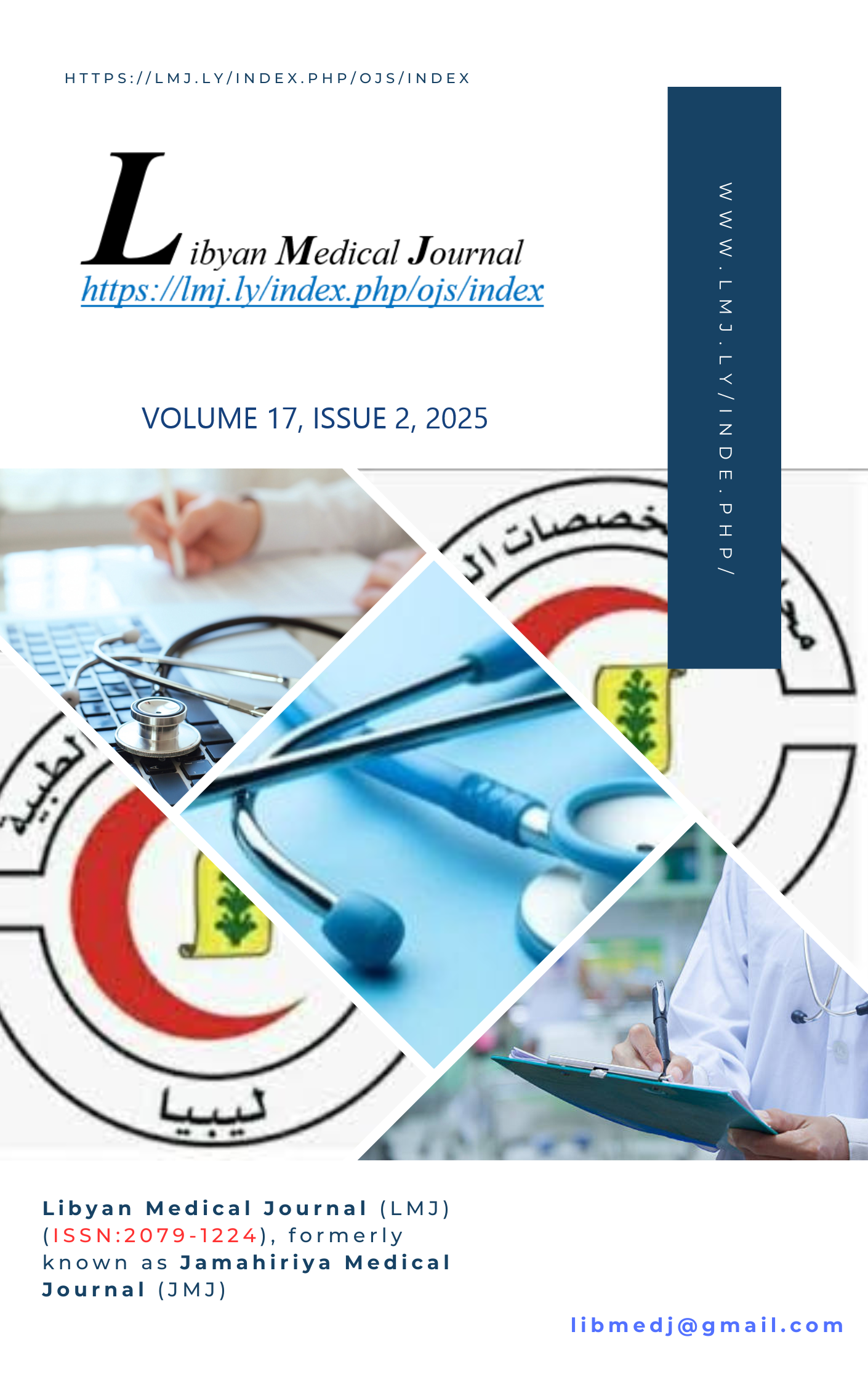Acne Association with Some Risk Factors, Including Fast Food and Cosmetics, Among Adolescent Males and Females
DOI:
https://doi.org/10.69667/lmj.2517214Keywords:
Acne, Risk Factors, Fast Food, Cosmetics, Self-Perception, AdolescentsAbstract
Acne is a common dermatological condition influenced by various genetic, dietary, and lifestyle factors. This cross-sectional study was conducted in Al-Ajelat city, Libya, to assess the association between acne and risk factors such as fast-food consumption, cosmetic usage, and perimenstrual flare. A total of 153 adolescent males and females participated, recruited from schools, colleges, and dermatology clinics. Data were collected through a structured questionnaire covering demographic information, family history, self-perception, dietary habits, cosmetic use, and medical opinions. The results showed that acne prevalence was higher among females (67.3%) and those aged 12–18 years (63.4%). A significant proportion (52.9%) had a family history of acne, suggesting a genetic component. Self-perception analysis indicated moderate psychological effects, including lower confidence and self-esteem. Dietary patterns revealed frequent consumption of fast food (58.8%) and sugary foods (58.2%), which may contribute to acne development. Cosmetic usage was relatively low, with 77.1% avoiding loose powder and 83% not using foundation. Statistical analysis using the Chi-square test and logistic regression identified significant associations between acne and lifestyle factors. These findings highlight the need for awareness programs promoting healthy dietary habits, skincare routines, and psychological support for individuals affected by acne.
References
Elsadek S, Obaid Z, Hashem O, Abdelmaksoud A. Psychological effects of acne vulgaris among secondary school adolescents in Damietta Governorate. Int J Med Arts. 2021;3(1):1163-71.
Elkamshoushi AM, Elneily DA, Omar SI, Mohamed HM. Serum levels of 25-hydroxyvitamin D and IL17A and their association with acne severity in patients with severe and very severe acne vulgaris. J Egypt Women Dermatol Soc. 2021;18:15-21.
Chuah SY, Goh CL. The impact of post-acne scars on the quality of life among young adults in Singapore. J Cutan Aesthet Surg. 2015;8(3):[page numbers needed].
Chilicka K, Maj J, Panaszek B. General quality of life of patients with acne vulgaris before and after performing selected cosmetological treatments. Patient Prefer Adherence. 2017;11:1357-61.
Tasoula E, Gregoriou S, Chalikias J, Lazarou D, Danopoulou I, Katsambas A, Rigopoulos D. The impact of acne vulgaris on quality of life and psychic health in young adolescents in Greece. Results of a population survey. An Bras Dermatol. 2012;87(6):862-9.
Harlim A, Pritarianti PA. The relation between face cleansing with acne vulgaris case. J Adv Res Dermatol Cosmet. 2023;2:1-4.
Tan AU, Schlosser BJ, Paller AS. A review of diagnosis and treatment of acne in adult female patients. Int J Womens Dermatol. 2018;4(2):56-71.
Fox L, Csongradi C, Aucamp M, du Plessis J, Gerber M. Treatment modalities for acne. Molecules. 2016;21(8):[article number needed].
Sutaria AH, Masood S, Schlessinger J. Acne Vulgaris. Treasure Island (FL): StatPearls Publishing; 2021.
Gollnick H. Current concepts of the pathogenesis of acne. Drugs. 2003;63(15):1579-96.
Donnet-Hughes A, Duc N, Serrant P, Vidal K, Schiffrin EJ. Bioactive molecules in milk and their role in health and disease: The role of transforming growth factor-β. Immunol Cell Biol. 2000;78(1):74-9.
Adebamowo C, Spiegelman D, Danby F, Frazier A, Willett W, Holmes M. High school dietary dairy intake and teenage acne. J Am Acad Dermatol. 2005;52(2):207-14.
Adebamowo C, Spiegelman D, Berkey C, Danby F, Rockett H, Colditz G, et al. Milk consumption and acne in adolescent girls. Dermatol Online J. 2006;12(4):1.
Bilgic A, Bilgic Ö, Çolak RS, Altınyazar HC. Relationship between acne vulgaris and attention-deficit/hyperactivity disorder symptoms in a clinical sample of women. An Bras Dermatol. 2016;91(2):[page numbers needed].
Minerva P, Hefni D. Determination of Vitamin C, Vitamin A and Flavonoid Levels in Garcinia cowa Roxb Fruit Flesh Extract. Int J Adv Sci. 2022;12(4):1593.
Thiboutot D, Gilliland K, Light J, Lookingbill D. Androgen metabolism in sebaceous glands from subjects with and without acne. Arch Dermatol. 1999;135(9):1041-5.
Perera MPN, Peiris WMDM, Pathmanathan D, Mallawaarachchi S, Karunathilake IM. Relationship between acne vulgaris and cosmetic usage in Sri Lankan urban adolescent females. J Cosmet Dermatol. 2018;17(3):431-6.
Dréno B, Bettoli V, Araviiskaia E, Sanchez Viera M, Bouloc A. The influence of exposome on acne. J Eur Acad Dermatol Venereol. 2018;32(5):812-9.
Levin J. The relationship of proper skin cleansing to pathophysiology, clinical benefits, and the concomitant use of prescription topical therapies in patients with acne vulgaris. Dermatol Clin. 2016;34(2):133-45.
Poli F, Auffret N, Beylot C, Chivot M, Faure M, Moyse D, et al. Acne as seen by adolescents: results of questionnaire study in 852 French individuals. Acta Derm Venereol. 2011;91(5):531-6.
Khan A, Chang MW. The role of nutrition in acne vulgaris and hidradenitis suppurativa. Clin Dermatol. 2022;4(2):[page numbers needed].
Minerva P, Hefni D. Determination of Vitamin C, Vitamin A and Flavonoid Levels in Garcinia cowa Roxb Fruit Flesh Extract. Int J Adv Sci Eng Inf Technol. 2022;12(4):1593-8.
Fajri L, Minerva P. The relationship of fast food towards the event of acne vulgaris in students. Int J Nat Sci Eng. 2022;6(2):55-63.
White GM. Recent findings in the epidemiologic evidence, classification, and subtypes of acne vulgaris. J Am Acad Dermatol. 1998;39(2):S34-7.
Lynn DD, Umari T, Dunnick CA, Dellavalle RP. The epidemiology of acne vulgaris in late adolescence. Adolesc Health Med Ther. 2016;7:13-25.
Do TT, Zarkhin S, Orringer JS, Nemeth S, Hamilton T, Sachs D, et al. Computer-assisted alignment and tracking of acne lesions indicate that most inflammatory lesions arise from comedones and de novo. J Am Acad Dermatol. 2008;58(4):603-8.
Lydick E, Yawn BP. Clinical interpretation of health related quality of life data. In: Staquet MJ, Hays RD, Fayers PM, editors. Quality of Life Assessment in Clinical Trials. New York: Oxford University Press; 1998. p. 299-314.
Goh C, Cheng C, Agak G, et al. Acneiform Disorders. In: Kang S, Amagai M, Bruckner AL, et al., editors. Fitzpatrick's Dermatology. 9th ed. New York: McGraw-Hill; 2019. p. 1391-418.











